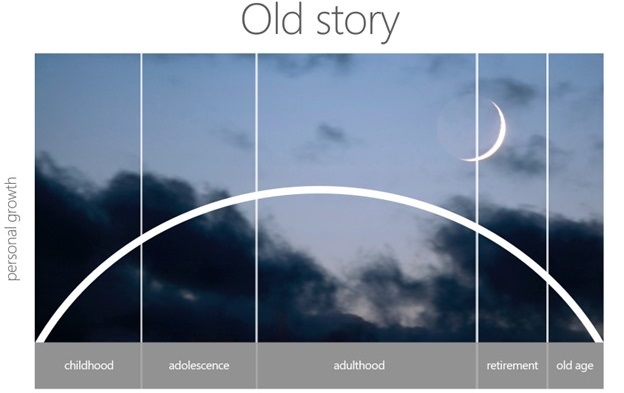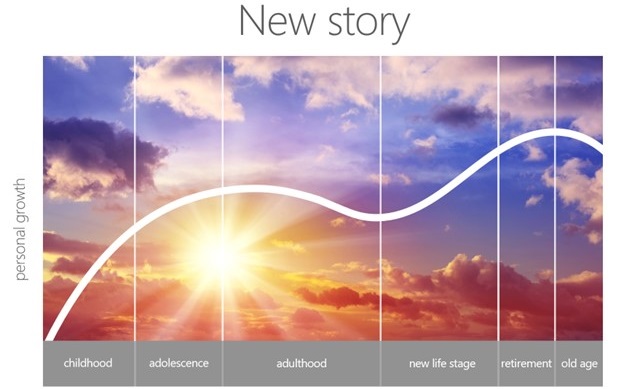The End of Retirement as We Know It
Baby Boomers face a retirement like no generation before them, and rather than being the 'beginning of the end,' it's the beginning of a new life phase.


As the largest cohort of Baby Boomers start turning 65 this year, a point when most people traditionally stop working for a living, they will experience “a retirement” unlike any other generation.
For starters, they will be happier than previous generations of retirees, and rather than sit on a porch gazing at sunsets and looking backward, they want to do more, according to researchers. They will also live longer and have more energy thanks to advances in medicine, technology and living healthier. Significantly more people say they will work into their 70s than any prior generation. While many will struggle financially to live comfortably throughout their retirement, no generation has retired with as much money saved as the Boomers.
They will also experience changes they had not anticipated.
From just $107.88 $24.99 for Kiplinger Personal Finance
Become a smarter, better informed investor. Subscribe from just $107.88 $24.99, plus get up to 4 Special Issues

Sign up for Kiplinger’s Free Newsletters
Profit and prosper with the best of expert advice on investing, taxes, retirement, personal finance and more - straight to your e-mail.
Profit and prosper with the best of expert advice - straight to your e-mail.
As an executive life coach who has traveled more than 2 million miles around the world, meeting and talking with people confronting the end of their normal work life, I am a professional listener. And what I have heard loud and clear from people is this refrain over and over: “This isn’t what I was expecting!”
For some, it’s a divorce or the beginning of a new relationship. Many thought they would still be working, only to unexpectedly lose their job, while others surprised themselves by starting a new business. Rather than preparing for a traditional retirement, many are facing periods of multiple changes and transitions, unprecedented in previous generations.
It’s what I call the “new life phase” — a time for facing new opportunities and challenges that seem to come out of nowhere, and for stretching out the productive, creative and purpose-driven peak of life.
A new life chart for a new life phase
For earlier generations, this time of challenge and opportunity and the need for having to keep figuring things out well beyond the normal retirement age, was not an option or necessary. Instead, society considered people at this stage to be “over the hill.” A popularly used life chart was shaped like an arc, rising through childhood, adolescence and part of adulthood, which was the so-called learning and earning phase of life. Then having reached a peak, the life chart went into steady decline through retirement and old age.

That chart was based on assumptions that are no longer true, such as people grew old in their 40s and 50s and died in their mid-60s, which was the case in the middle of the last century. Even now, as life expectancy has risen, people often are mistaken about where they are on the life chart. A recent economic study about retirement-aged Boomers by economist Robert Shapiro on behalf of the Retirement Income Institute noted that people in their 50s and early 60s underestimate their likelihood of living until just 75 by an average of 25%.
The best way to illustrate the change in aging is a new chart showing a steady rise into early adulthood and then a leveling through middle age until we reach another rise past middle age that stretches into a new peak, which represents the new life stage. Psychologists worldwide have found that well-being follows a U curve, and that happiness is at its lowest level when people are in their 30s and 40s and then increases steadily starting at age 50. This happiness trajectory aligns with research that finds our lives continue to evolve positively in our later years.

Start the new phase by talking it over with someone you admire and trust
This new phase of life can feel a little bit like a second adolescence. We find the structures we fit into comfortably a decade ago — socially, professionally, relationally — start to feel like a poor fit. We need a new purpose, a new vision, encouragement and a personal plan to make this newly available phase of life our best life.
The plan should be shared with others. When I tell people about my studies and interviews with older people about “aging with purpose,” they often give me examples of more people I should interview. Their instinct to keep talking about this change is right, because turning to those you admire is a great starting point for any new adventure.
The new phase of life involves having a purpose in life, whether it is a job, being a mentor, having connection to others or a spiritual connection. The new life phase can take on a whole new dimension when you discuss it with partners, friends, family and colleagues. In a variety of ways, we feed off one another’s ideas, stories and insights. The results benefit everyone.
Related Content
- Your Retirement Reckoning: Four Questions to Ask
- Is 100 the New 70?
- The Five Stages of Retirement (and How to Skip Three of Them)
- Nervously Nearing Retirement? Four Do’s, Four Don’ts and One Never
- Being Rich vs. Being Wealthy: What’s the Difference?
Profit and prosper with the best of Kiplinger's advice on investing, taxes, retirement, personal finance and much more. Delivered daily. Enter your email in the box and click Sign Me Up.

Richard Leider is an Education Fellow with the Alliance for Lifetime Income’s Retirement Income Institute and Founder of Inventure – The Purpose Company, a firm created to guide individuals to live, work and lead on purpose. He is ranked by Forbes as one of the “Top 5” most respected coaches and is a contributing author to many coaching books. He is one of a select few coaches who have been invited to work with over 100,000 leaders from over 100 organizations such as AARP, Ameriprise, Blue Zones, Ericsson, Habitat for Humanity, Lifespark, Mayo Clinic, Modern Elder Academy, National Football League, Outward Bound, United Health Group and the U.S. Department of State.
-
 Nasdaq Sinks 418 Points as Tech Chills: Stock Market Today
Nasdaq Sinks 418 Points as Tech Chills: Stock Market TodayInvestors, traders and speculators are growing cooler to the AI revolution as winter approaches.
-
 23 Last-Minute Gifts That Still Arrive Before Christmas
23 Last-Minute Gifts That Still Arrive Before ChristmasScrambling to cross those last few names off your list? Here are 23 last-minute gifts that you can still get in time for Christmas.
-
 The Rule of Compounding: Why Time Is an Investor's Best Friend
The Rule of Compounding: Why Time Is an Investor's Best FriendDescribed as both a "miracle" and a "wonder," compound interest is simply a function of time.
-
 If You're a U.S. Retiree Living in Portugal, Your Tax Plan Needs a Post-NHR Strategy ASAP
If You're a U.S. Retiree Living in Portugal, Your Tax Plan Needs a Post-NHR Strategy ASAPWhen your 10-year Non-Habitual Resident tax break ends, you could see your tax rate soar. Take steps to plan for this change well before the NHR window closes.
-
 Could Target-Date Funds With Built-In Income Guarantees Be the Next Evolution in Retirement Planning?
Could Target-Date Funds With Built-In Income Guarantees Be the Next Evolution in Retirement Planning?With target-date funds falling short on income certainty, retirement plans should integrate guaranteed income solutions. Here is what participants can do.
-
 Your Year-End Tax and Estate Planning Review Just Got Urgent
Your Year-End Tax and Estate Planning Review Just Got UrgentChanging tax rules and falling interest rates mean financial planning is more important than ever as 2025 ends. There's still time to make these five key moves.
-
 What Makes This Business So Successful? We Find Out From the Founder's Kids
What Makes This Business So Successful? We Find Out From the Founder's KidsThe children of Morgan Clayton share how their father's wisdom, life experience and caring nature have turned their family business into a respected powerhouse.
-
 Past Performance Is Not Indicative of Your Financial Adviser's Expertise
Past Performance Is Not Indicative of Your Financial Adviser's ExpertiseMany people find a financial adviser by searching online or asking for referrals from friends or family. This can actually end up costing you big-time.
-
 I'm a Financial Planner: If You're Not Doing Roth Conversions, You Need to Read This
I'm a Financial Planner: If You're Not Doing Roth Conversions, You Need to Read ThisRoth conversions and other Roth strategies can be complex, but don't dismiss these tax planning tools outright. They could really work for you and your heirs.
-
 Could Traditional Retirement Expectations Be Killing Us? A Retirement Psychologist Makes the Case
Could Traditional Retirement Expectations Be Killing Us? A Retirement Psychologist Makes the CaseA retirement psychologist makes the case: A fulfilling retirement begins with a blueprint for living, rather than simply the accumulation of a large nest egg.
-
 I'm a Financial Adviser: This Is How You Can Adapt to Social Security Uncertainty
I'm a Financial Adviser: This Is How You Can Adapt to Social Security UncertaintyRather than letting the unknowns make you anxious, focus on building a flexible income strategy that can adapt to possible future Social Security changes.